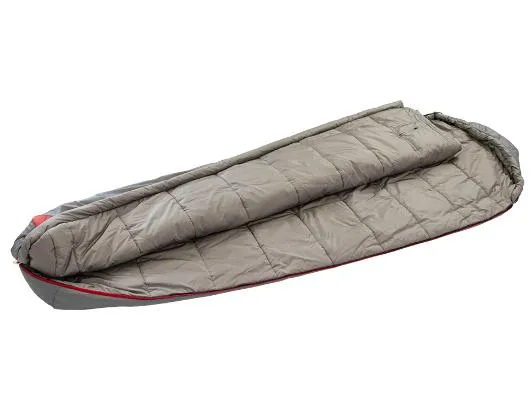
أغسطس . 01, 2025 15:00 الرجوع للقائمة
Practical Comfort for Every Camper
If you're searching for a reliable and budget-friendly sleeping bag, look no further than the polyester sleeping bag. It’s one of the most widely used and appreciated types of sleeping bags for casual campers, families, and weekend adventurers. Its versatility, ease of care, and affordability make it a popular choice for both beginners and experienced outdoorspeople.
The polyester sleeping bag is known for being lightweight and quick-drying. Unlike natural fibers, polyester does not absorb water easily, making it ideal for humid or mildly damp conditions. It also resists mildew, so you won’t have to worry about unpleasant odors developing after a rainy night.
In terms of construction, these bags typically use polyester for both the outer shell and inner lining, along with synthetic polyester insulation. This all-poly build results in a product that’s durable, easy to clean, and generally hypoallergenic.
Because they are so easy to manufacture, polyester sleeping bags are also available in a wide range of sizes, shapes, and colors. You’ll find everything from lightweight mummy bags to extra-large rectangular options for more relaxed camping.
Whether you're heading to a festival, taking the kids out for their first tent night, or just want an affordable backup sleeping bag, the polyester sleeping bag is a smart and practical option.

Sleeping Bag for Spring Camping: Lightweight Warmth and Breathability
Spring is one of the best seasons for camping—temperatures are mild, flowers are blooming, and campgrounds are less crowded. But choosing the right sleeping bag for spring camping is key to staying warm during chilly nights and comfortable during warmer mornings.
The ideal sleeping bag for spring camping offers a moderate temperature rating—usually between 35°F and 50°F. That means it should keep you warm during unexpected cold snaps but still be breathable enough to prevent overheating when it’s warmer.
Materials matter here. Many spring bags use polyester sleeping bag shells and insulation because polyester is light, moisture-resistant, and comfortable. These bags are often less bulky than winter bags, making them perfect for car camping or short backpacking trips.
Ventilation features are another advantage. Some sleeping bags for spring camping include dual zippers, foot vents, or convertible designs so you can regulate airflow depending on the weather. You might even want to choose a semi-rectangular or rectangular shape for more movement and airflow inside the bag.
Spring weather is notoriously unpredictable, so having a sleeping bag that’s flexible, easy to pack, and quick to dry is essential. For campers who want to travel light but stay comfortable, a good sleeping bag for spring camping—especially one made of polyester—is the perfect seasonal gear addition.
Best Material for Sleeping Bag: Choosing the Right Fabric and Insulation
When it comes to sleeping bags, one of the most commonly asked questions is: What’s the best material for sleeping bag performance, durability, and comfort? The answer depends on your use case, but polyester often tops the list for overall value.
For the outer shell, polyester is widely considered one of the best materials for sleeping bag construction. It is lightweight, dries quickly, resists UV degradation, and is relatively tear-resistant. Compared to nylon, polyester is slightly more breathable, which is ideal for spring or summer use.
For insulation, synthetic polyester fill is also a top contender. It's less expensive than down, continues to insulate when damp, and doesn’t require as much special care. Hollow fiber polyester insulation mimics the loft of down while being more durable and hypoallergenic. This makes it particularly suitable for kids, new campers, and allergy-prone individuals.
As for the lining, brushed polyester or taffeta is common and feels soft against the skin. It's warm enough for cooler nights but doesn't trap heat like some heavier materials. If you're choosing a sleeping bag for spring camping, polyester linings provide the perfect balance of softness and breathability.
While down may offer better weight-to-warmth performance, the combination of affordability, low maintenance, and moisture resistance makes polyester the best material for sleeping bag designs intended for casual or 3-season use.
Why Polyester Sleeping Bags Are Ideal for Everyday Use
Many outdoor gear brands continue to innovate with advanced fabrics and high-tech insulation, but the classic polyester sleeping bag remains a go-to for everyday adventurers. Why? Because it's tough, budget-friendly, and easy to live with—on the trail or in the closet.
A polyester sleeping bag doesn’t require special storage bags or delicate washing routines. It can be tossed in a standard washing machine (on cold with mild detergent), hung to dry, and ready for use again the next weekend. That ease of care makes it an ideal choice for families, scout groups, or rental fleets.
Its durability is another key benefit. Unlike down, which can lose loft or clump when wet, polyester maintains its structure and insulative properties. That makes it perfect for rough-and-tumble trips or outdoor scenarios where gear gets a little abused.
Polyester also offers excellent color retention and fade resistance, so your sleeping bag continues to look good even after many washes and nights under the stars.
Whether you’re car camping, hosting sleepovers, or planning a spring hiking getaway, the polyester sleeping bag is a workhorse. It’s not fancy—but it’s functional, dependable, and cost-effective. And that’s exactly what most campers need.
The Smart Choice for Spring: Polyester Sleeping Bags That Work
If you're preparing for the changeable weather of early-season adventures, there's one clear winner: a sleeping bag for spring camping made from high-quality polyester. These bags combine practical features, sensible materials, and budget-conscious design to deliver all the comfort you need for the season.
Spring camping is about adaptability. Your gear has to perform on cool nights, mild mornings, and everything in between. That’s why polyester, often regarded as the best material for sleeping bag construction in transitional seasons, is such a smart choice. It's breathable, warm, and easy to pack.
Add features like zippered vents, integrated pillows, or convertible mummy-to-blanket shapes, and you’ve got a bag that will keep you comfortable in various spring environments—from beachside camping to national park hikes.
And if you shop smart—especially during seasonal gear promotions—you'll likely find a polyester sleeping bag with all these features at a price that won’t stretch your budget.
Invest in a sleeping bag that meets your real-world needs. Whether you’re new to camping or a seasoned outdoor enthusiast, choosing a sleeping bag for spring camping made from polyester is a decision you’ll appreciate on every trip.
polyester sleeping bag FAQs
Is a polyester sleeping bag warm enough for spring camping?
Yes, a polyester sleeping bag with appropriate insulation (usually synthetic hollow fiber) is more than warm enough for spring conditions. Look for temperature ratings around 35–50°F for optimal comfort during early or late spring.
What are the main advantages of polyester as the best material for sleeping bags?
Polyester is quick-drying, affordable, and low-maintenance. It resists mildew, retains its shape when damp, and is generally hypoallergenic. These qualities make it one of the best materials for sleeping bag construction for general use and spring camping.
How do I wash and maintain a polyester sleeping bag?
Wash your polyester sleeping bag in cold water using a mild detergent. Avoid bleach or fabric softeners. Use a front-loading washing machine if possible. Hang dry or tumble dry on low. Always store the bag loosely in a breathable sack to maintain loft.
What should I look for in a sleeping bag for spring camping?
Key features to consider include temperature rating (35–50°F), moisture resistance, breathability, and lightweight materials like polyester. Ventilation options, a hood, and packability are also useful for spring's changing conditions.
Is down better than polyester for sleeping bags?
Down offers better warmth-to-weight ratio and compressibility, making it ideal for ultralight or cold-weather camping. However, polyester is more affordable, easier to care for, and retains warmth better when wet—making it the smarter choice for casual and spring camping.
-
Baggu Picnic Blanket: Waterproof, Sandproof, Extra-Large
أخبارNov.17,2025
-
Camping Picnic Mat: Waterproof, XL, Foldable, Durable
أخبارNov.17,2025
-
Foldable Picnic Rug - Waterproof, Lightweight, XL Comfort
أخبارNov.17,2025
-
Camping Picnic Mat – Waterproof, Extra Large & Portable
أخبارNov.17,2025
-
Camping Picnic Mat - Waterproof, Extra Large, Portable Rug
أخبارNov.17,2025
-
Outdoor Rug for Picnic – Waterproof, XL, Foldable with Bag
أخبارNov.17,2025
